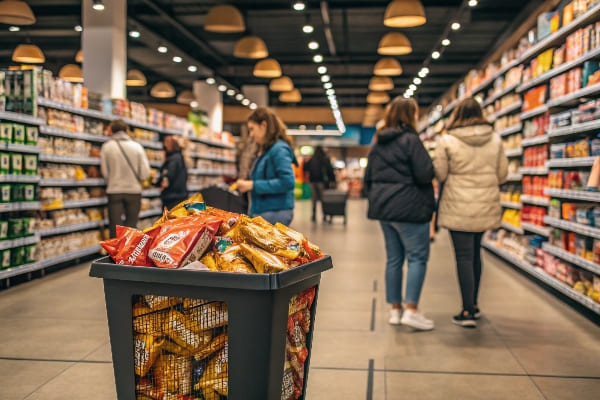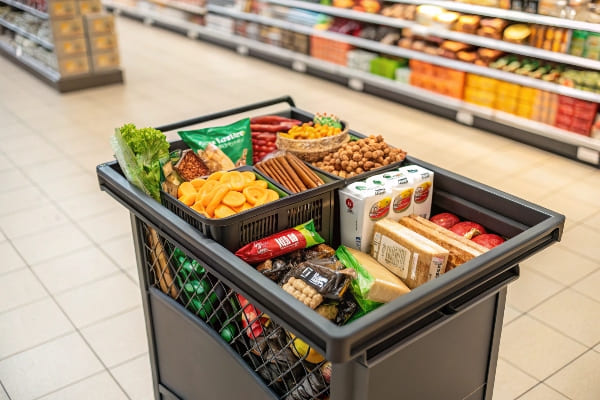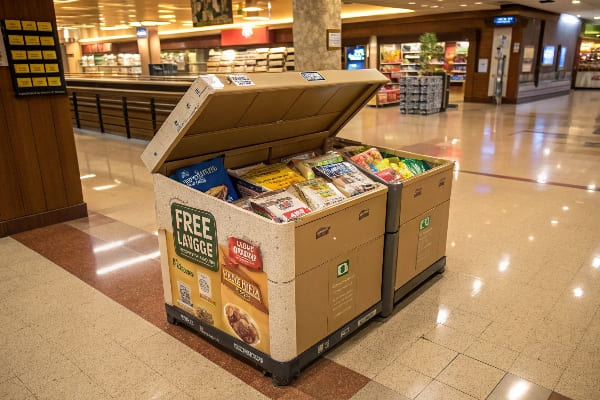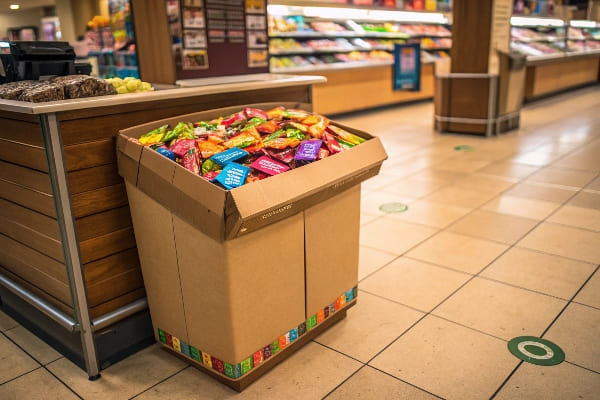Many promotions fail because small products vanish on packed shelves. I watched customers walk past them every day until dump bins turned those items into instant attention-grabbers.
Dump bins lift impulse sales, clear shelf space, and speed stock turns by grouping loose products in a simple floor container that shoppers can reach from every side.

Curious how one low-cost fixture can do so much? Let me walk you through every angle so you can decide if dump bins fit your merchandising plan.
What are dump bins in retail?
Crowded aisles make shoppers skip small add-ons. That lost revenue stings. A dump bin steps in, gathers the products, and puts them center stage.
A dump bin is a freestanding box or barrel that holds loose, individually packed items so customers can dig, pick, and buy on impulse.

Why the format works
Dump bins succeed because they turn scattered stock into a single, eye-level hotspot. Shoppers see volume, equate it with value, and feel safe taking a handful. When I rolled out my first unit—plain corrugated board with bright branding—unit sales of low-price add-ons jumped 35 % in one week.
| Key Factor | Impact on Sales | My Observation |
|---|---|---|
| Bulk presentation1 | Signals bargains | Customers grab multiples |
| 360° access2 | Faster browsing | Shorter queues around bin |
| Refill ease | Less labor | One worker tops up in seconds |
Beyond sales, dump bins save shelf footage. In my factory I prototype each design, load-test to 15 kg, and ship flat. That lets buyers like David from Barnett Outdoors open, fill, and launch a promotion the same day, even under tight launch dates. Finally, cardboard bins are recyclable, so stores meet sustainability goals without extra cost. In short, a dump bin is not just a box; it is a silent salesperson working all day.
What is the dump process in retail?
Shops often treat replenishment as an afterthought, leading to empty fixtures and disappointed shoppers.
The dump process is the routine of refilling, tidying, and rotating stock within a dump bin to keep it visually full and safe to shop.

Simple steps, serious payoffs
I break the process into three steps: inspect3, top-up, and refresh graphics4. Inspection catches crushed packs before customers do. Top-up5 keeps the bin looking abundant; scarcity signals higher price, not value. Refreshing graphics—peeling off torn corner stickers—maintains brand trust.
| Step | Frequency | Tip from My Floor |
|---|---|---|
| Inspect | Every shift change | Pull damaged packs for repack |
| Top-up | When fill drops below 70 % | Use pre-counted polybags |
| Refresh graphics | Weekly | Keep spare headers near bin |
For high-velocity items I stage sealed cartons beside the bin. A staff member opens one, tips it in, and is done in under a minute. That speed matters in peak hours. By standardizing the dump process, our clients cut labor by 20 % while keeping the fixture full, a win for both cost and customer experience.
What is a bin in retail?
Retail terms can blur. New hires might call every container a “bin,” which confuses ordering and design.
In retail, a bin is any open container—shelf tray, basket, or floor box—used to hold merchandise for self-service selection.

How bins differ and why it matters
Not all bins are equal. A shelf bin6 sits on a gondola and keeps SKUs neat. A wire basket7 often hangs and supports bulk deals. A dump bin stands alone and invites rummaging. Choosing the wrong type can cost sales. One client displayed premium electronics in a wire dump style; theft soared. We switched to a lidded acrylic bin8, preserving visibility but adding security.
| Bin Type | Typical Location | Best For | Potential Risk |
|---|---|---|---|
| Shelf tray | Gondola shelf | Sorted small SKUs | Limited visibility |
| Wire basket | Endcap or hook | Bulk packaged snacks | Product falls through |
| Dump bin | Floor space | Impulse, low unit cost | Over-handling damage |
Knowing the difference lets you brief suppliers clearly. At Popdisplay, we tailor corrugated bins by weight, footprint, and graphics so buyers can match function to product. That clarity speeds prototyping and stops wasted rework, which aligns with lean budgets and tight launch windows.
What is a dump display?
Retailers crave fresh hooks to stop foot traffic. Static shelves fade into the background.
A dump display is a promotional setup where the dump bin acts as a central prop, often wrapped with seasonal graphics and paired with headers or side panels.

Turning a plain box into a mini show
A dump display9 combines the bin with eye-level signage, floor decals, and sometimes lighting. The goal is to build a micro-theater10 around low-cost goods. One sporting-goods chain placed my crossbow wax packs in a rugged-print bin, topped with a deer silhouette header. They sold through two weeks before hunting season.
| Display Element | Purpose | Quick Build Advice |
|---|---|---|
| Header card | Brand message | Die-cut for silhouette |
| Side wings | Extra facings | Hinge for flat pack |
| Floor graphic | Zone border | Use removable vinyl11 |
The beauty is speed. Because my factory prints header, wings, and bin in one pass, the buyer assembles the full scene in under five minutes without tools. That simple theater thrills marketing teams who battle for floor space. As a result, dump displays punch above their weight, delivering campaign impact without permanent fixtures.
What is dump bin meaning?
Language gaps across regions can slow projects. “Dump bin” may sound negative or casual to some merchants.
“Dump bin” means a temporary retail container designed for bulk presentation of small, individually packaged goods, encouraging impulse purchase through visual abundance.

Why the term matters in global trade
When U.S. buyers like David email specs to our Guangzhou plant, precise vocabulary12 avoids costly errors. If he writes “PDQ” (Pretty Darn Quick) instead of “dump bin,” we know he wants a small counter unit, not a floor stand. Mislabeling can lead to prototypes that miss the height spec by half a meter.
| Term | Region | Common Size | Notes |
|---|---|---|---|
| Dump bin | US/UK/AU | Floor, 800–1200 mm | Often cardboard |
| PDQ | US | Counter, <300 mm | Pre-filled |
| Bunker | UK grocery | Metal, pallet | Heavy goods |
Understanding the meaning also guides material choices13. Cardboard suits seasonal or lightweight items. Metal bins serve clearance toys. Plastic works for wet areas. By aligning language, we cut sampling rounds, keep freight on schedule, and protect margins. Clear words build trust, and trust keeps repeat orders flowing—the core of my business model.
Conclusion
Dump bins are simple, low-cost tools that boost impulse sales, save labor, and flex with any promotion. Adopt them, refine the refill routine, and watch small products move fast.
Understanding how bulk presentation influences customer behavior can enhance your retail strategy and boost sales. ↩
Exploring the benefits of 360° access can help retailers optimize store layouts for better customer engagement. ↩
Exploring this resource will provide you with effective strategies to enhance your inspection process and improve customer satisfaction. ↩
Discover how refreshing graphics can enhance brand trust and customer engagement in your retail space. ↩
This link will offer insights on maintaining product availability and optimizing sales through effective top-up strategies. ↩
Learn how shelf bins can optimize product organization and enhance customer experience in retail environments. ↩
Discover the benefits of wire baskets for displaying bulk products effectively and attracting customer attention. ↩
Explore the advantages of lidded acrylic bins for product security and visibility, enhancing your retail display strategy. ↩
Explore this link to understand how dump displays can enhance product visibility and sales in retail environments. ↩
Discover how the micro-theater concept can create engaging shopping experiences and boost customer interest. ↩
Learn about the advantages of removable vinyl for creating flexible and eye-catching retail displays. ↩
Understanding the significance of precise vocabulary can enhance communication and reduce errors in international transactions. ↩
Learning about material choices can optimize product selection and enhance supply chain effectiveness in global markets. ↩

